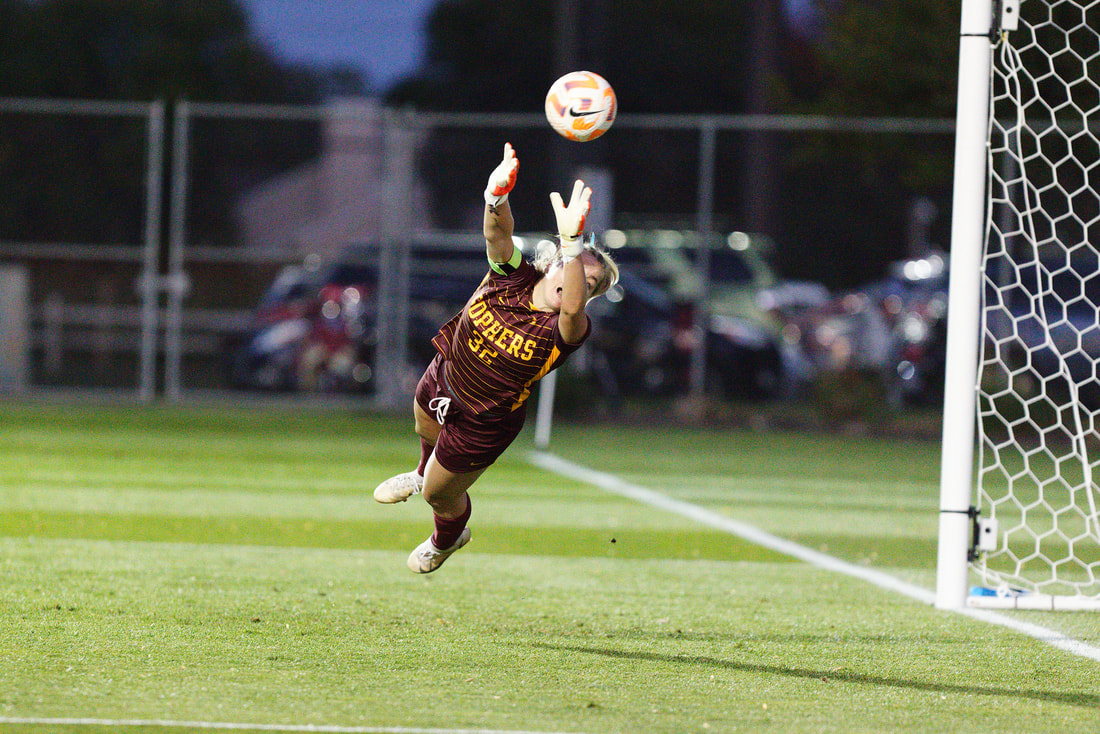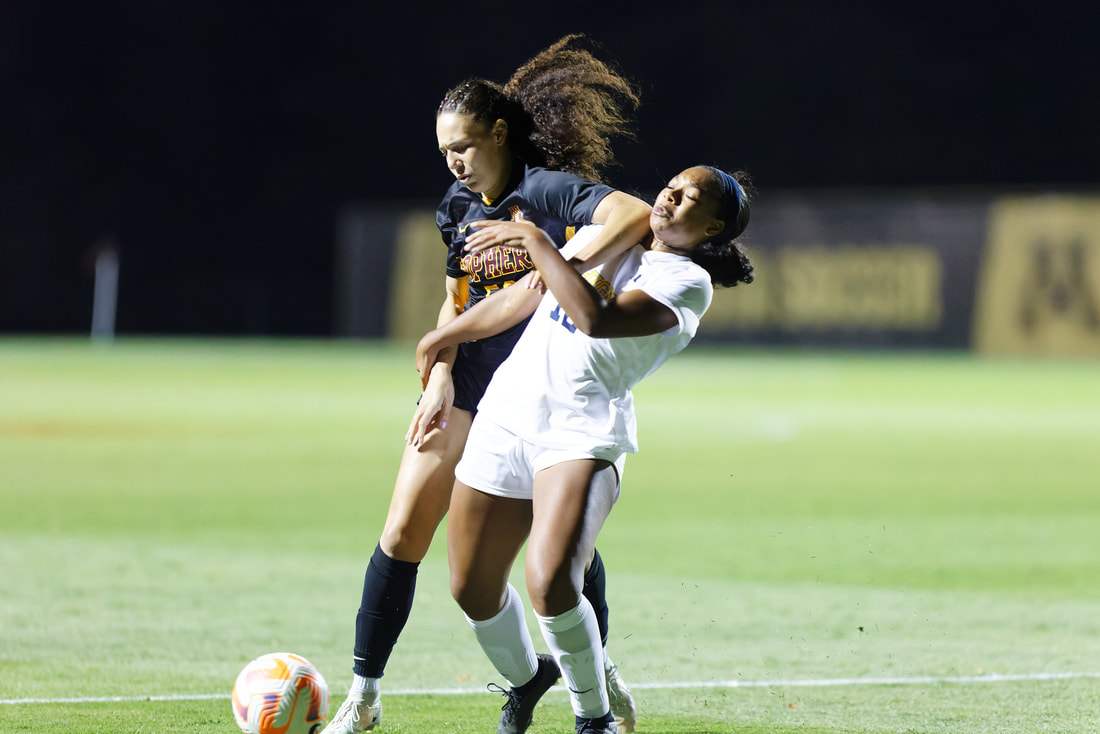|
Author: Matt Privratsky
In a fall filled with late game give-aways, the Gopher soccer team finally grinded out a win over their southern border rivals, securing a 1-0 win over the Iowa Hawkeyes. The narrow victory also kept Minnesota’s equally narrow (but fairly realistic) Big Ten Tournament hopes alive. Let’s dive in.
Grind out a close (or any) game Close games are not rare in Big Ten soccer. And late game lead changes are all that rare either. What is somewhat rare for Gopher Soccer is almost entirely falling on the losing side of both of those game types for almost an entire season. The match against Iowa was maybe the first of the season where Minnesota earned a slim lead and actually defended it until the final whistle. As I am *far* too regularly pointing out: Minnesota — across multiple head coaches, a half dozen seasons, and dozens of different players overall — has fairly consistently played to their competition (showers least against bottom teams, showing up to tougher matchups, etc). In the past, that trend has also come with a side of grit and determination that leads to just enough wins to make up for the tough losses. With several tough give aways under their belt already, the Gophers will have to string a few of those grit-it-out results together. So nabbing one against Iowa was crucial.
Veteran team battling rookie mistakes We don’t like to dwell on the negative, but one trend that is almost impossible to ignore are the almost silly mistakes that have swung games this season. We’ve seen seasons where veteran-laden teams just don’t play to their potential all the time (2017 & 2018 had stretches like that), but it’s still a little jarring. Michigan may be a good team but their only goal against MN was still a complete giveaway. Northwestern may be a *very* good team but their game winner was another complete defensive flub. Both games could have been great results if Minnesota could have avoided those mistakes and pulled off ties. With so many veterans making up the core of the rotation (only two freshman and three sophomores seeing real minutes) those silly mistakes are what you’d hope to avoid. At the same time, the team has shown the ability to battle through some ugly stretches of game play and find ways to settle in. So if those rookie mistakes can be snuffed out in their final four games…they have a real chance to raise their ceiling.
Close games means ruthless rotation tweaks There is something really respectable about how Head Coach Erin Chastain and the Gopher coaching staff has managed Minnesota’s rotation this season. At the individual level (or, as an individual player) I’m guessing it can feel borderline brutal. We’ve seen folks pulled almost instantly if things are trending in the wrong direction on the defensive end, in particular. But from the outside, there also seems to be a bit of fairness (or equal opportunity risk) in who is subjected to the quick change. Stalwarts like Abi Frandsen, Lauren Donovan, and Delaney Stekr have all seen their roles shift in one game or more but it’s never been a lifetime banishment. They’ve always been replaced by capable options behind them and also frequently (rightfully) keep a (slightly tweaked) place in the rotation regardless. What it would say to me, if I were a player, is that: no role is guaranteed, performance during the games matters, and (if I’m not in the rotation currently) I can always fight to earn a spot. Obviously it also means some added stress of never truly “owning” your exact role but that stress might already be there anyway. And again, considering how close the score lines have been, the coaching staff might not feel like it has that long of a leash. Early word on (regular) seniors With so many players still eligible to become super seniors by using their extra year of NCAA eligibility granted to them in exchange for living through what has been the party that is our most recent global pandemic, it’s hard to know how and when to even begin processing “regular” seniors legacies. In other words, I don’t want to start mourning the end of the Sadie Harper era until necessary, etc. In an effort to help *you* avoid preliminary emotional stresses, here is the latest intel on those honored on what we will call “regular senior day” last weekend. Sadie Harper, Megan Plaschko, and Izzy Brown are reportedly returning. Eva Bruer is likely to move on. Gabbie Cesarone got honored even though she’s a 5th year (irregular senior? We’ll keep workshopping) cause she didn’t have a previous regular senior day for the Gophers but she is obviously also departing (along with Meg Gray, Kenna Buisman, Delaney Stekr, Alana Dressely, etc). Watch the shape There is one trend that is almost impossible to miss as you watch games week in, week out: the spacing and shape of the Gophers and their opponents. To my substantially untrained soccer brain it feels like this single issue is one that leads to several other challenging symptoms that then have to be dealt with. To an actually qualified coach, technical director, player, etc it might be clear that the spacing is a symptom of other core issues and not a root cause of other issues etc but we’ll pretend my observation is not backwards for now. In most college soccer games you see spacing break down pretty aggressively throughout the game. Maybe ten times a game you could take a picture of the whole field where all 20 field players are within roughly 30 or 40 yards of each other on a field that is just under 120 by 80 yards, for instance. But what has stuck out recently is what the Gophers face when they play a team that has even moderately (or, sometimes, much) more discipline in their offensive shape. Michigan and Northwestern are the games that stick out most in our memories but I’m sure it’s been true other times too. The disciplined team shape is actually a result of ten individual players making dozens of moment by moment decisions almost literally every second of the game to: not get sucked in toward the ball if it’s not coming to them, maintain width (even if you’re checking to the ball) that gives a passing lane to the ball handler, and continually scan to find the *right* space to be in (not just space in general). When a critical mass of players on any given team makes just enough of these decisions it then forces the defending team to stretch to the offensive team’s shape and open up cleaner passing and dribbling channels – providing desperately needed grease to help unlock the gears of the offense that can so easily seize up in grind-it-out moments of Big Ten play. The challenge is, if your opponent is spacing out like this, it can sometimes make it *feel* like your advantage could be down the center of park. If they’re wide, we have room to operate down the middle! But a team that’s disciplined enough to maintain a solid offensive shape is frequently also disciplined enough to adjust their shape behind the ball to block the most obvious chances and force the other team (MN) to engineer a “half court” offense – maybe one of the most difficult things to pull off for the Gophers in our era covering them. Again, that’s probably attributing a bit too much to shape alone. But there are certainly games where spacing and shape alone seem to have predetermined how the run of play will go for the entire match. For MN, finding the discipline to have incredibly intentional offensive shape at all times probably isn’t super realistic. So keeping a higher line defensively (on all three lines) that can cause some turnovers and get some of Minnesota’s attackers like the Sophias (Romine, Boman, etc) on the ball with open field in front of them is likely the lower hanging fruit. MN still controls their own destiny (essentially) Here’s we stand on the Gophers “Return to the Tournament” campaign. They are in 9th place in the Big Ten standings. They still have a game against the 8th place team (Illinois) and the most dangerous team beneath them (Michigan) has some pretty tough games remaining. So the Gophers essentially control their own destiny.
Their remaining games are against Rutgers (even a tie would be incredible), Maryland (must win), Purdue (must win), and Illinois (must win). This is sort of like last year when the Gophers had five games left that all felt winnable and doing so would have had them finish so high that they’d host a Big Ten Tournament game and I proudly proclaimed they could go 5-0 and then they stumbled so badly that they didn’t even make the field at all. So, you know… But this year, the goals are pretty damn modest. A record around .500 typically gets you into the tournament field (top 8). Even if they drop the tough game against Rutgers they can finish at 5-5 in Big Ten play by winning (not tying) the other very manageable games. So if you’re a Gopher player and you’re reading this (they *all* obviously do, I’m sure), here’s my two cents: play like you have nothing to lose against Rutgers – truly no rules. Just try shit. Cause who the hell is picking you to win? Go in there and steal a point with some chaos and make all those New Jersey players have a crappy weekend. Then, keep that chaos/try-shit mentality going through the final three games. You all face pressure that none of us fans (certainly not me) face on a daily basis. Go out there and rip and we’ll be here to cheer for every “try-shit” move/shot you attempt.
2 Comments
3/27/2023 08:57:39 pm
Thanks for sharing this information. I have been looking everywhere to know about this. Awesome content.
Reply
4/30/2024 01:01:31 am
The analysis presented in this post offers valuable insights into the complexities of gambling culture. It's fascinating to see how games like Satta King have become embedded in the fabric of society, shaping cultural norms and traditions. Speaking of which, I recently stumbled upon an article on the Sattagalidisawar site that delves into the psychological aspects of <a href="https://sattagalidisawar.in/"> Satta King </a>. It provides a fascinating exploration of the motivations driving players and the allure of risk-taking behavior. A must-read for anyone interested in understanding the psychology behind gambling!
Reply
Leave a Reply. |
Full Archive
July 2024
|


